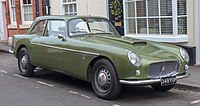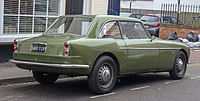Bristol 406
| Bristol 406 | |
|---|---|
| Chronology | |
| Predecessor | Bristol 404 and 405 |
| Successor | Bristol 407 |
The Bristol 406 was a
It was the last Bristol to use the
Body
A prototype with a body by Carrosserie Beutler AG of Thun in Switzerland was exhibited in 1957 in both Paris and London Motor Shows. The start of production at Filton was announced in late August 1958.[4]
Engine
Compared to the
Manufacture of the 2-litre version continued for supply to AC Cars for their AC Ace and Aceca.
Disc brakes
The 406 also featured Dunlop-built
The rear
Zagato
Two short-wheelbase 406s, known as 406Ss, were bodied by Zagato.[7] In all, there were only six 406s with Zagato bodies.[8] Rather than the 105 hp (78 kW) of the standard cars, these received a fettled engine with 115 hp (86 kW) and a stainless Abarth exhaust, which combined with the considerably lighter weight to make a spirited performer out of the 406.[2]
-
Bristol 406 Zagato
-
Side
-
Rear
-
Zagato Badge
Replacement
The engine's ageing design was dealt with in 1961 by replacing it with a 5-litre Chrysler V8. The resulting car was renamed Bristol 407.
Notes
- ^ a b c d e "1958 Bristol 406". carfolio.com. Retrieved 1 January 2008.
- ^ a b c Setright, L J K (January 1974). Fraser, Ian (ed.). "And now, a quick look at Setright's Bristols". CAR Magazine. London: National Magazine Company: 76.
- ISBN 9781874105930
- ^ New Bristol Car For £4,493. The Times), Tuesday, Aug 26, 1958; pg. 10; Issue 54239
- ^ Setright, L. J. K. "Bristol: A Quiet Touch of Class", in Northey, Tom, ed. World of Automobiles (London: Phoebus, 1978), Volume 2, p.234.
- ^ Setright, p.232fn.
- ^ Setright, p.232 f.n. & pp. 234-235.
- ^ Setright, p.234 f.n.




